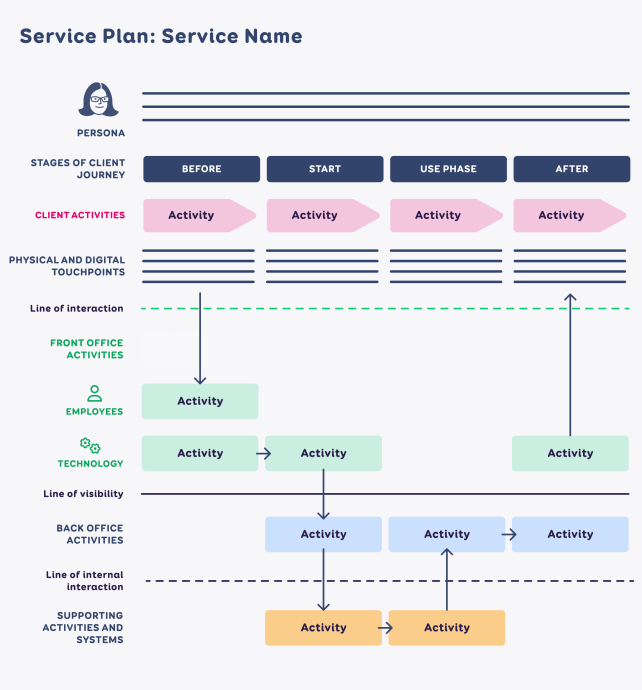Service Plan - Visualizing Processes for Better Customer Experience
You might have heard of the "customer journey" as a design method, but the concept of a "service blueprint" might still be new to some.
Designing an excellent customer journey is crucial, but if an organization can't function smoothly in delivering its services, then a great customer experience can't be sustained for long. Mapping a service blueprint is a method that helps integrate service usage and delivery into a cohesive whole, being a key tool in service design.
What is a Service Blueprint?
A service blueprint visualizes the relationships between different parts of a service, such as processes, employees, and other resources. These components are linked to points where the customer and the service interact.
The blueprint aids in planning and optimizing organizational processes and resources to offer the service in the best possible way, thereby ensuring a great customer experience.
Difference Between a Service Blueprint and a Customer Journey?
The customer journey tells the story of a customer's experience using a product or service, detailing their actions, feelings, motivations, and arising questions.
While the customer journey focuses on the customer and service usage, the service blueprint primarily reflects the organization's perspective, focusing on service delivery and employees. By mapping the organization's processes and resources, the service blueprint aims to directly improve the employee experience and indirectly the customer experience.
However, this doesn't mean that the service blueprint ignores the customer experience or journey. It should be seen as an extension of the customer journey, using the customer experience as a starting point for showing how the organization supports the customer through its processes and employees. The service blueprint provides a broader picture of how the organization offers the service and how customers use it.
Tip: if you're unsure how your customers experience your service, start by mapping the customer journey. Once you have a good understanding of the customer experience, creating a service blueprint is your next step.
Why Use a Service Blueprint?
Create a service blueprint when your goal is to...
- Improve services by discovering weaknesses in the organization (like activities that consume unreasonable amounts of money, time, or energy) and finding opportunities to optimize processes.
- Design new services by thoroughly thinking through the parts related to service delivery and their interrelationships before launching a new service.
- Understand how service delivery works by getting an overview of complex services involving various communication channels and touchpoints or requiring joint contributions from different parties.
- Develop a shared understanding of service delivery in the organization.
A service blueprint is particularly suitable for services involving both digital and non-digital touchpoints. It's not the best method for designing purely digital services; in such cases, mapping the customer journey or processes is more appropriate.
Components of a Service Blueprint
Each service blueprint can be somewhat unique, but it should map the following elements:
How to Create a Service Blueprint?
Before creating a service blueprint, decide whether to map the current situation (as-is) or the ideal situation (to-be). Mapping the current situation helps identify existing problems, while mapping the ideal situation finds solutions to issues and sets development goals for the service.
Creating a service blueprint is inherently a team effort in service design. Therefore, conducting a collaborative workshop for creating the service blueprint is beneficial. This allows discussion and agreement on themes. For mapping, you can use a large board and sticky notes or an online environment like Miro.
The process of creating a service blueprint can be divided into six steps:
1. Define the service to be mapped
Select one service for mapping. Since a service plan itself can contain a lot of information, it is advisable not to make it more complicated by adding multiple services to the plan.
2. Define the customer or customer segment (persona)
Similarly to the principle of the previous point, choose one customer or customer segment whose needs and journey you wish to base the service plan on. If there are multiple different alternatives for consuming a service (e.g., eating in at a restaurant or ordering takeaway), then it is advisable to create different service plans for these.
3. Map the customer's activities
The creation of the service plan should start with the customer's activities. Describe the customer's activities step by step from the beginning to the end of the service usage journey. Map all the touchpoints with the service throughout the customer's lifecycle. What does the customer do when they select, purchase, use, evaluate, or stop using the service?
If the customer journey has already been mapped previously, it can be taken as a basis. Remember that the service plan focuses on the employee experience, not so much on the customer experience, therefore the service plan should only describe the customer's touchpoints with the service and parallel activities, not the entire customer journey with all its details.
4. Map all physical and digital touchpoints
Consider all the physical and digital elements (e.g., communication channels, environments, objects, individuals, documents) that the customer encounters while using our service or product for each customer activity.
5. Map the employees' activities (frontstage and backstage activities)
This is the most important part of the service plan. Map the employees' activities related to each customer activity. Depending on whether the customer sees the activity taking place or not, categorize the employee activity as either frontstage or backstage.
The simplest way is to move column by column, first mapping the frontstage activity, then the backstage activity, and then moving on to the next customer activity.
6. Map the supporting activities
Add to the service plan activities performed by other employees or partners who do not participate in the interaction but whose activities support the work of the frontstage and backstage employees.
Tip: here, you don't have to limit yourself to just the customer. You can also map all the objects and environments that employees encounter in providing the service, marking those as inventory, for example.
To interlink activities and describe dependencies between them, it is advisable to connect the appropriate activities with arrows. Arrows have specific meanings.
A single arrow indicates a linear relationship, meaning one activity controls another. A double-sided arrow, however, indicates a dependency, meaning the parties involved in these activities need to reach an agreement for the process to move forward (e.g., agree on package delivery with a partner).
Tip: for better comprehensibility and clarity of the service plan, it is sometimes sensible to divide a path into smaller paths (e.g., divide frontstage activities into (1) interactions between customer and employee and (2) interactions between customer and technology) or to divide the entire customer journey into smaller stages.
How to enhance a service plan?
A service plan can be as simple or as detailed as necessary. If you are new to it, avoid making the service plan too complicated - sticking to the version described above is perfectly optimal. For more advanced applications, the following information blocks can be added to the service plan as separate tracks for added value:
1. Temporal Dimension
Since some activities may last 5 seconds, while others several hours or even days, adding a temporal dimension to the service plan provides a better understanding of the service delivery.
You could describe the average duration of the service or the customer's minimum expectation for each step from the customer's perspective. This helps to understand whether the service is efficient and meets customer expectations.
2. Metrics
Adding metrics gives an understanding of the aspects by which customers deem the service good or bad (e.g., waiting time length). It's sensible to assess the current situation and set priorities in service development against these metrics.
3. Emotions
Mapping emotions helps to understand how disturbed or motivated an employee is during a particular activity. Suitable for use in mapping the current situation. To map emotions, it is advisable to use icons and a legend to keep the plan as understandable and clear as possible.
4. Regulations
Understanding the regulations associated with the service helps to know what can and cannot be optimized in processes.
5. Opportunities
Mapping the current situation reveals problem areas, and discussions can lead to opportunities and suggestions for improving the service. These should also be added to the service plan as a separate line.
Tip: where words are not enough, you can add pictures, drawings, and icons. For example, pictures can convey the specifics of objects and places, and icons can indicate problematic areas where too much time, money, or nerves are spent. However, be cautious that the service plan does not become unclear due to an overload of information.
Done! What next?
Once you have mapped the current situation and identified problem areas, it's time to move on to envisioning the future and start visualizing solutions to these challenges. Once the ideal service delivery plan is clear, it should be implemented.
If you didn't create the service plan just for practice, don't let it gather dust in a drawer; bring it to life. Define goals, priorities, an action plan, and metrics. If necessary, conduct a pilot project of the service to get feedback on the viability of the service concept, which can help refine the service.
To ensure that all employees have the vision in mind and know their role in service delivery, it is advisable to display the service plan in a visible place in the office. A service plan is never final - it evolves over time with changes in customer expectations, technology advancements, national regulations, etc. Therefore, it should be periodically reviewed and updated.








